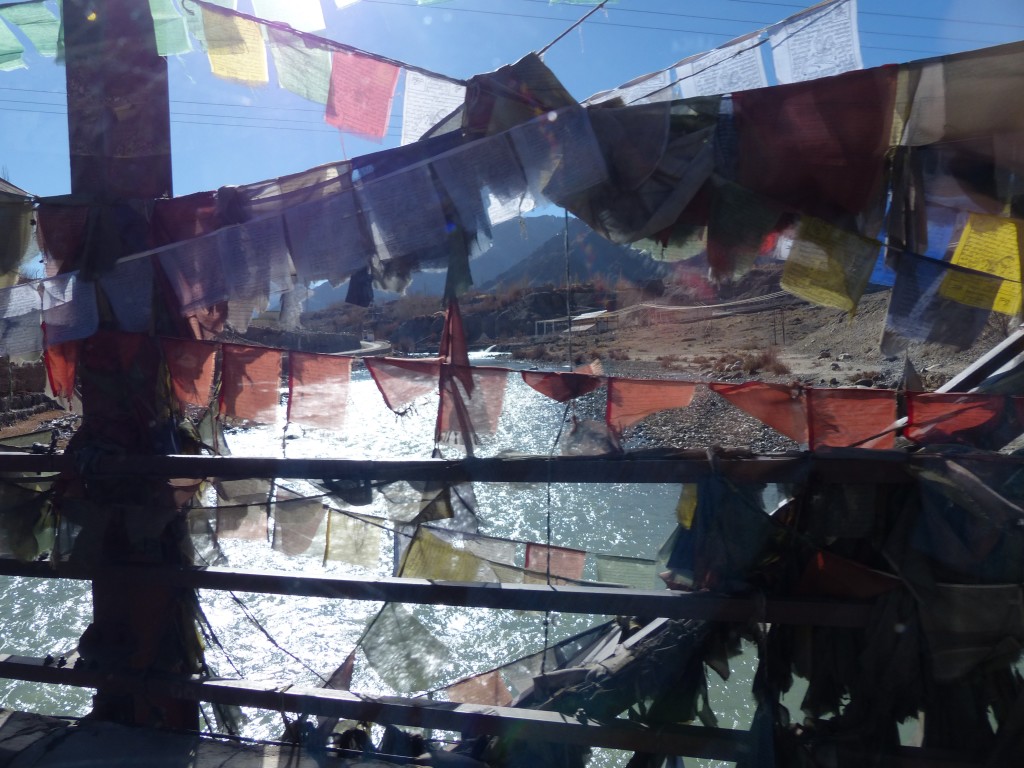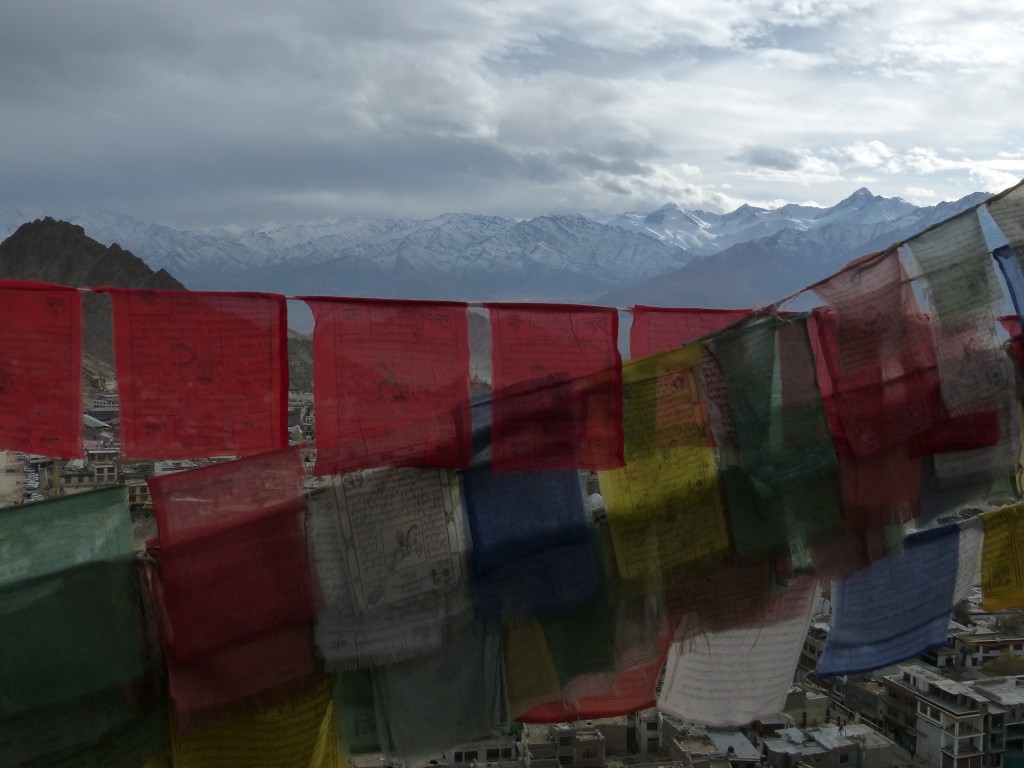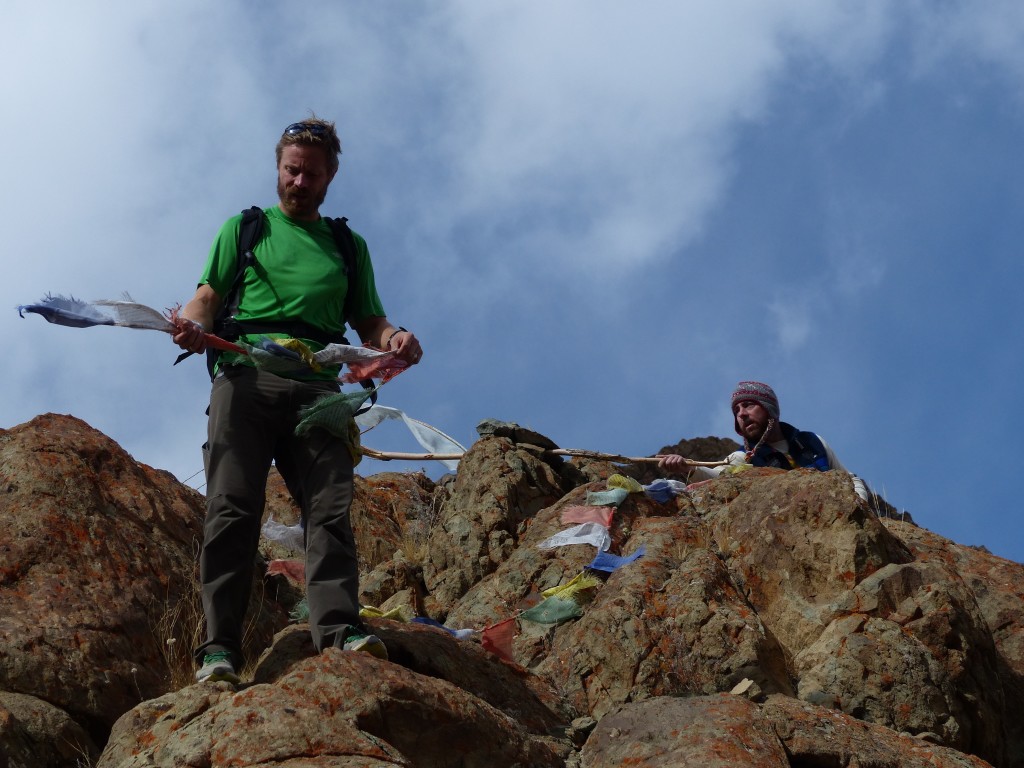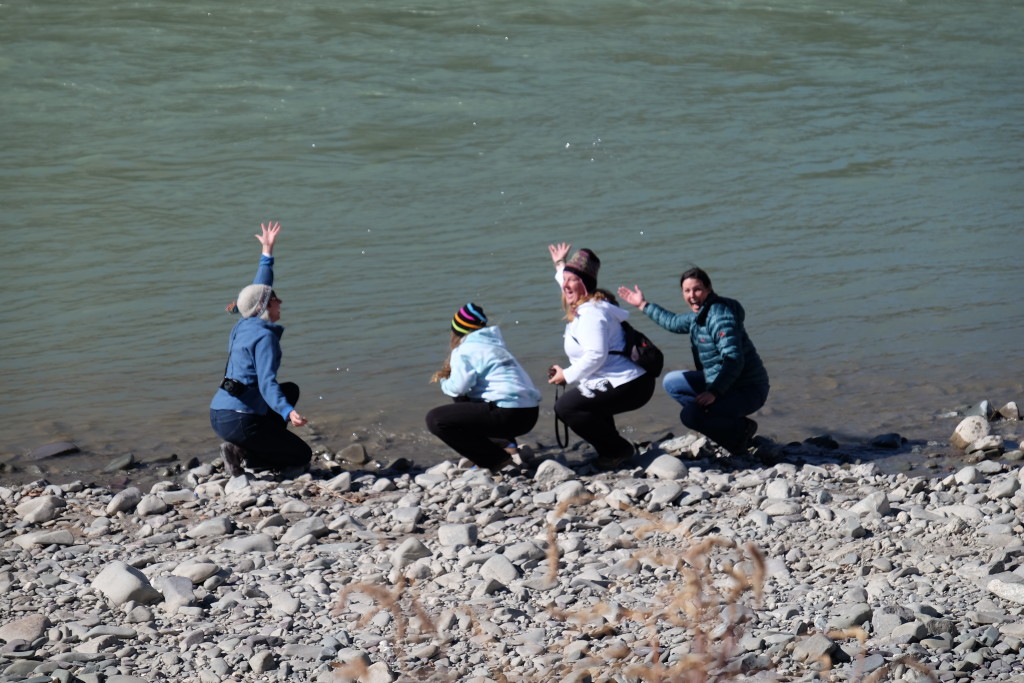Leaving Delhi Wednesday morning, November 11, the smog was so thick one of the kids in our group asked, “Can the plane really take off in this?” Just an hour later, though, we looked out the plane windows at the snowcapped Himalayas and a sapphire sky.

At Ladakh Sarai, our home for the next few days, we sucked in big breaths of fresh cold air and looked out at the horizon, where mountains rose up to the clouds. “What you see there is called ‘the distance,’” I explained. “It’s been a long time since we’ve been able to see into the distance!”
Tony and I were among 26 people – teachers and their kids – who traveled to Leh for the Diwali long weekend. Leh is the high-desert capital of the Ladakh district in the northern Indian state of Jammu and Kashmir.
The Ryder-Walker Alpine Adventures website explains:
Situated on the western end of the Himalayas, Ladakh has four major mountain ranges – the great Himalayan, Zanskar, Ladakh, and the Karakoram all passing through it. A maze of enormously high snow capped peaks and the largest glaciers outside the polar region dominate the terrain where valley heights range from 800 to 15000 feet with passes up to 20,000 feet and peaks reaching 25, 000 feet can be seen all around. Ladakh is also home to the world’s largest glacier outside the polar region, the Siachen.
Known as “Little Tibet,” Leh definitely reminded me of my trip to Tibet in 2009 (see my Farewell China Tour posts). In fact, I kept forgetting I was in India. The Tibetan influence was evident in the architecture, temples, prayer flags strung from nearly every tall structure, language, and the smiley gentle nature of the people.
Most of us had taken Diamox, a drug for preventing altitude sickness, in the days leading up to our trip. Although my symptoms included a racing heart, tingly fingers and long stretches of lethargy, I didn’t feel the horrifying sensation that my eyeballs were about to explode, as I did in Tibet.
Tony and I were assigned a yurt at the edge of Ladakh Sarai’s property. Inside, pink and green woven cloth draped the bedroom walls, and beige fabric with turquoise polka dots billowed down from the ceiling and attached to the walls about 5 feet from the floor. The double bed was comfortable with a thick, heavy duvet for the chilly nights. A cabinet painted with colorful dragons and traditional designs held another blanket, just in case. A wood-burning stove sat in the middle of the room with a pipe carrying the smoke out a hole in the ceiling.
Entering the Ladakh Sarai camp.

The “foyer” and entrance to the bathroom.

The first night, we discovered the stove was not at all easy to regulate. It got the room cozy warm, then swelteringly hot, to the point where I had to get up in the middle of the night, strip off my pajamas and go into the adjoining icy cold bathroom for a few minutes. When the fire burned out in the early morning, the room turned frigid. Tony and I had watched the workers light our stove several times, and we thought we were doing exactly the same thing, but our fire simply wouldn’t stay lit. It flared up and then petered out after about 10 minutes. We used about a liter of kerosene and 73 matches, but we finally generated a big enough blaze to warm up the yurt for a couple more hours.
Our yurt overlooked a neighboring farm with terraced fields strewn with straw and a lone black yak. Tibetan prayer flags fluttered from the farmhouse rooftop. The land sloped gently down to a treeline, beyond which the town of Leh nestled in the valley. From our bed, we could watch the morning sun glitter on the snowy mountaintops, turn the barren rocky hillsides a warm gold, and then slowly creep toward us, brightening the valley, then the farm and finally creeping up and over the mud-brick wall to our yurt.

On our first day in Leh, Sarah and I took a quick walk around the camp’s perimeter. Sarah was hoping to pet the yak, but alas, the farmers had constructed a serious blockade.

I loved the contrast of these orange berries against the brown-ness of everything else.

We found a small “mani wall” with prayer stones.

Looking back on our camp, where Kevin and Beth were hanging out in front of the duplexes.

Later, Sarah, Emma, Tony and I started off in search of “the village.” Following the advice of a Ladakh Sarai worker, we exited the gate and turned right to walk uphill. We crossed a metal bridge over a riverbed with only a rivulet of water rushing through. We saw signs of high water and past flooding, though, as well as efforts to contain the banks with blankets of chicken wire and intentional rerouting of the water through a smaller channel down the center of the rocky floor.
We had only walked about 10 minutes when we reached a fork in the road. To the left, a large group of villagers were doing some kind of work with shovels and mounds of soil. We hesitated to walk through them, so we considered taking the road to the right. Sarah asked a man, “Which way is the village?” He pointed toward the workers. “Saboo Village.” Sarah pointed to the other road and asked, “Is there another village?” He laughed and pointed in all directions. “Nothing village,” he said. So we ventured into the crowd.
The workers smiled at us as they shoveled soil into piles on the right side of the road next to a tall wall. At the uphill end of the wall was a small stupa made of mud bricks, topped with a pole and a prayer flag. The workers had clearly just built a reinforcing wall out of mud bricks, about 4 feet high, at the base of the taller wall. Upon closer inspection, we saw the top half of the wall comprised large smooth rocks inscribed with the mantra “om mani padme hum.” The website Dharma-Haven has a nice explanation of that complicated mantra.
We paused to watch them work for a moment, and soon a lady called out to me, “Tea?” At first I declined, but then the whole group stopped working for a tea break, and we decided to join them. They kindly served us cups of chai and crackers for dipping. As soon as everyone finished their tea, they got right back to work. It seemed only fair to pitch in. The ladies grabbed empty rice sacks from a bin, threw them down on the ground and waited for the men to shovel some soil on top. A woman would then pick up either end of the bag and carry it to the far end of the wall to heave the soil onto a big pile. Sarah and I each found a partner and hauled a few bags of soil. “Very good!” one lady said to me after we dumped our load. Everyone sang as they worked, a tune simple enough that we could somewhat follow along, although we didn’t know what we were singing.
As we mingled, Emma took some photos with Sarah’s phone, and Tony chatted with a young man whose foundation had organized this volunteer effort. Sonam Wangchock, founder of the Himalayan Cultural Heritage Foundation, told us village elders say the wall is more than 300 years old. Heavy rains had eroded much of the base, threatening to topple the whole thing. He explained that Buddhists come to pray, making the traditional circumambulation on the path circling the wall. The extra soil was moved off the road to protect it from passing vehicles, he noted. It will be used to make plaster in the spring, when volunteers return to plaster over the mud bricks and finish the work they started on the historical wall.

See more photos at the HCHF’s Facebook page.
Back at Ladakh Sarai, everyone was hanging out in the communal building, made up of several connected round rooms – two for dining and two for lounging, as well as a few other small work spaces. The dining rooms had trapezoidal tables painted with lovely Tibetan designs and lined up so everyone could sit on the perimeter benches and face each other. The two lounging areas featured wood-burning stoves in the middle, surrounded by cushions or sofas. Such a comfy spot to play cards or chat while sipping a hot ginger-lemon drink.
Breakfast and lunch were served buffet style from a low stove in the center of the communal yurt. Dinner, on the other hand, was an elegant affair with candles, pleated napkins and metal trays in lieu of plates. The waiters brought course after course of delicious Western and Indian food.

One night, we all sat around a fire outside, roasting marshmallows and playing games.

Day two in Leh, we all piled into vans to visit the Tibetan market in town and Leh Palace. After 15 years in Asia, there’s not much that Tony and I haven’t bought at one time or another. Still, it was fun to poke through the piles of toasty yak wool blankets, cases of silver jewelry, Tibetan handicrafts, and knock-off name-brand bags and clothing. We filed up several flights of stairs for a lunch of soup and momos (dumplings), and then headed to the palace.
According to the book Ladakh – The Complete Guide by Nicholas Eakins, Leh Palace was constructed “using traditional Ladakhi methods, with dried mud-bricks constituting the upper levels, and the lower levels constructed on a natural plinth of stone using rammed earth, stone and timber,” and the walls slope inwards for additional strength. A sign outside the 9-story palace said construction started in 1553 by Tswang Namgyal, founder of the Namgyal Dynasty, to be a miniature version of Potala Palace in Lhasa, the capital of Tibet. At the very top, we could see faded painting, which made me wonder whether the whole place was once brightly painted. Today, it’s mud colored and very cold, dark and dusty. If I were queen back then, I think Tswang would have heard a lot of complaining.
Nyla photobombed our palace pic.

On the morning of day three in Leh, we drove about 45 minutes to a trailhead near the village of Stok. The trail ran alongside a streambed with mountains on either side. Several of us hiked up to the top of a big hill, about four hours round-trip. If we had continued on the path, we could have reached the snowy peak of Stok Kangri, 6123 meters high. That wasn’t going to happen.
Evan and Bernie climbed up a bit further to re-string some fallen prayer flags.

Gorgeous colors on the way back to the vans.

Day four in Leh took us to a couple monasteries, known as gompas.
We drove a long way Hemis Monastery, the largest monastic institution in Ladakh. To get there, we crossed the Indus River on a metal bridge draped with Tibetan prayer flags. Our vans crawled up a switchback road through dormant barley fields and grazing yaks until finally, we turned a corner and found the monastery hidden behind towering sand-colored hills.
Inside, we took off our shoes to enter a temple, where monks were chanting prayers. One monk kept time on a painted vertical drum, and occasionally the others would chime in with a bell, cymbals or a horn. Upstairs, we visited the Kali Devi temple, full of ominous images of the vengeful goddess. We climbed up the roof and enjoyed the vista for a while. Tony and I turned the prayer wheels and then wandered by a small room, where two monks were lighting lamps of ghee. The older monk invited us in and handed Tony a candle to light the lamps. He showed us one huge lamp that apparently burns for a whole month. Later, that same monk did a little laughter therapy/clapping game with others in our group. Outside the monastery building, young monks were busy with chores – fetching water, washing robes, mixing concrete, sweeping, and we realized the “village” clinging to the hillside was really living quarters for the monks.

Leaving the monastery, we paused for a quick splash in the icy Indus River.

From there, we headed to the 15th-century Thiksay Monastery, perched on a hilltop overlooking the river valley. Only two rooms were accessible. The Maitreya Temple featured a 2-story gilded statue, inaugurated in 1980 by the Dalai Lama, and murals depicting scenes from Maitreya’s life. The other open room included many glass boxes with small dolls representing various Buddhist entities. It’s not unusual for temple visitors to leave money or other auspicious gifts, but this room had an unusual collection of bangles and hairclips left as offerings. If you know why, please do tell!

Driving back to camp, we passed through the former Ladakhi capital of Shey, where hundreds of white-washed chortens (stupas) dot the countryside. According to The Rough Guide to India:
Among the more visible expressions of Buddhism in Ladakh are the chess-pawn-shaped chortens at the entrance to villages and monasteries – large hemispherical burial mounds-cum-devotional objects, prominent in Buddhist ritual since the third century BC. Made of mud and stone (now also concrete), they are imbued with mystical powers and symbolic significance: the tall tapering spire, normally divided into 13 sections, represents the soul’s progression towards nirvana, while the sun cradled by the crescent moon at the top stands for the unity of opposites, and the oneness of existence and the universe.
While my heart sank at the thought of leaving Leh, I vowed to return home with a smile. It’s been a week, and that Leh-induced joy lingers. When can we go back?





































